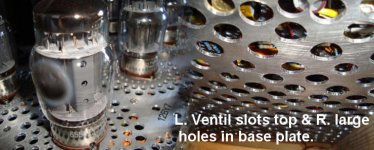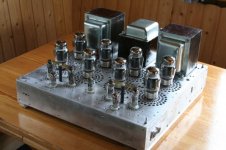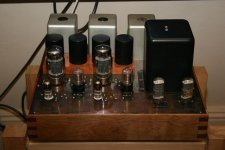Expanding the range of your question; wood makes a perfect material for amp boxes; I use small parts of aluminum sheets for fast securing the inputs/outputs and tube sockets... A wooden box yields a more delicate sounding treble compared to steel and aluminum (disclaimer: try first, criticize later). To top if off, 6-bottle wine crates (reïnforcing the bottom=top sheet with another sheet of wood) are MEANT to end up as tube amplifiers.
Simon a.k.a. "Woody"
Simon a.k.a. "Woody"
To top if off, 6-bottle wine crates (reïnforcing the bottom=top sheet with another sheet of wood) are MEANT to end up as tube amplifiers.
Bravo!! Drinking the crate contents make sound even better!
Having myself used steel, aluminium, wood and corian as chassis materials, I find wood or Corian to be "quietest". Build the same circuit on different materials and hear the difference yourself.
Currently I am into bamboo cutting boards as chassis and have recently purchased two of them, one alternates light and dark bamboo in stripes and is very pretty, very cheap too
I have no proof as to whether or not it is inductances, stray fields or whatever you choose to select but the difference between the non metallic materials and the metallic materials is not subtle.
Both wood and corian are a heck of a lot easier to machine than metal (the corian makes a mess though).
Andrew
Currently I am into bamboo cutting boards as chassis and have recently purchased two of them, one alternates light and dark bamboo in stripes and is very pretty, very cheap too
I have no proof as to whether or not it is inductances, stray fields or whatever you choose to select but the difference between the non metallic materials and the metallic materials is not subtle.
Both wood and corian are a heck of a lot easier to machine than metal (the corian makes a mess though).
Andrew
Re: Re: Chassis metal advantages/disadvantages?
I know Ally smells orrid' and messy/black when worked on but I use ordourless white spirit (or lamp oil) for drilling and punching without any clogging problems. The sag problem ? brace it.
It is well-known in metal workshops where others are working that using aluminium on grinding wheels don't mix and violates safety regulations.
A woodworking rasp or a bastard (yes it's the correct word) is preferred. hard work ? nup.Not really.
richy
Miles Prower said:
Punches make nice holes in it, unlike aluminum, it's not sticky and doesn't chew up Dremmel cutting wheels, it doesn't take the edge off drill bits like aluminum. Big power xfmrs and OPTs don't cause it to sag under the weight.
I know Ally smells orrid' and messy/black when worked on but I use ordourless white spirit (or lamp oil) for drilling and punching without any clogging problems. The sag problem ? brace it.
It is well-known in metal workshops where others are working that using aluminium on grinding wheels don't mix and violates safety regulations.
A woodworking rasp or a bastard (yes it's the correct word) is preferred. hard work ? nup.Not really.
richy
Attachments
Rod - Good thing you don't live in an earthquake zone...Rod Coleman said:
The picture shows my B.300B-SE.
Aluminum is my preferred chassis material. It's easy to machine, easy to get, and reasonably priced. I have never had trouble painting it using ordinary spray paint.
I use some A-9 aluminum cutting oil when machining it. That's the key. Cutting fluid. It makes life much easier. In the past, I've used denatured ethanol alcohol (with proper ventilation). That works too. The same goes for other materials - use proper cutting fluid!!
Any conductive material will form an electrostatic shield. However, to my knowledge, only mu-metal will form a magnetic shield. Mu-metal needs to be formed and annealed before it obtains its magnetic properties. Any machining after the anneal will destroy (or at least degrade) those properties. Thus, it's generally out of reach for hobbyists...
~Tom
tomchr said:
Rod - Good thing you don't live in an earthquake zone...
Or within eye shot of the fire inspector ...
dsavitsk said:
Or within eye shot of the fire inspector ...
Did not you see an UL certificate glued to the chassis?
Rod Coleman said:The output transformer is remote from the amp
Could be a bit of a mess if that trafo (and a brick or two) came tumbling down... earthquakes where you live?
dave
bereanbill said:...I have seen one particularly creative builder on ebay who uses cake pans.
cake pans were the chassis of choice for the diy builders of the 40s & 50s.
dave
As Rich says, use Methylated Spirit (thats what its called in the U.K.) for machining Aluminium (Denatured Alcohol in the U.S.A., Spirits in Europe). Makes a world of difference when you use the correct fluid for cutting.
I know a guy who swears by WD40. Not so sure about that although if fish oil can clear your arteries then I suppose it will help cut Aluminium.
I know a guy who swears by WD40. Not so sure about that although if fish oil can clear your arteries then I suppose it will help cut Aluminium.
WoW!!! I feel both ashamed and sane here. Ashamed because I Thought I was an abstract thinker...not compared to some of you all.
Wavebourn...that is an incredible work of art you've got there ... Rich, yours as well. Rod...you need therapy, man. Are you perhaps related to Rube Goldberg?
I thought I might use copper for the look...I figured I could drill and punch it while it's flat, and then bend it. Laquered heavily, it shouldn't tarnish too quickly??? And Dr Rob...thanks for that link. You have all given me a lot of info to process...LOVE this forum !!!!
Wavebourn...that is an incredible work of art you've got there ... Rich, yours as well. Rod...you need therapy, man. Are you perhaps related to Rube Goldberg?
I thought I might use copper for the look...I figured I could drill and punch it while it's flat, and then bend it. Laquered heavily, it shouldn't tarnish too quickly??? And Dr Rob...thanks for that link. You have all given me a lot of info to process...LOVE this forum !!!!
I thought I might use copper for the look...I figured I could drill and punch it while it's flat, and then bend it.
Be careful when drilling copper. Its very gummy and likes to snag and break smaller drill bits.
Theres a 2x3' piece of 0.05" titanium sheet waiting in my garage but unfortunately I need a waterjet cutter and Bridgeport mill to do anything with it

Copper tarnishes readily and one is apt to use a polish that may be vapour corrosive to tube pins especially where silver is around. Another drawback in polished state is material that re-reflects heat to the o/p tubes (if real wattage is being used). This is generally for most shiny materials unless a crop of ventilation holes is used (as I do)-
Anyone who works brass and copper on a lathe knows too well the binding properties of both non ferrous metals.
When designing physicals for the larger power amps with multiple tubes, heat dissipation is important. Generally I use the GEC 4 inch centre to centre rule with hot side of anodes at right angles to each other. A fan could have been used but encourages dust and some noise. The chassis becomes rather large and serious underneath bracing is unavoidable. In this pic, a conservatively rated high performance 100+100W amp, the iron weight is considerable, 65kg or 143 lbs. same as my spouse !
richy
Anyone who works brass and copper on a lathe knows too well the binding properties of both non ferrous metals.
When designing physicals for the larger power amps with multiple tubes, heat dissipation is important. Generally I use the GEC 4 inch centre to centre rule with hot side of anodes at right angles to each other. A fan could have been used but encourages dust and some noise. The chassis becomes rather large and serious underneath bracing is unavoidable. In this pic, a conservatively rated high performance 100+100W amp, the iron weight is considerable, 65kg or 143 lbs. same as my spouse !
richy
Attachments
Rod...you need therapy, man.
You wouldn't say that when the music comes out of it...
astouffer said:
Theres a 2x3' piece of 0.05" titanium sheet waiting in my garage but unfortunately I need a waterjet cutter and Bridgeport mill to do anything with it
You should be able to find that on the side of the road out there in Pittsburgh!
My mill software "purportedly" drills copper by repeatedly plunging and lifting the bit. I say "purportedly" as I haven't gotten all the stuff installed.
Here are 2 dead-bug ultra low noise preamps built this year -- when you have to work with aluminum I just run a copper thread or a piece of MMM copper tape across the panel. Both of these amps are in the low single digit nV/rtHz
An externally hosted image should be here but it was not working when we last tested it.
An externally hosted image should be here but it was not working when we last tested it.
planet10 said:
cake pans were the chassis of choice for the diy builders of the 40s & 50s.
dave
I've used a few of these
http://www.surfasonline.com/productlines/214.cfm
Thick industrial cake pans. Very ultilitarian, but work well. I get my self-etching primer from the auto-parts store.
An externally hosted image should be here but it was not working when we last tested it.
Easy & cheap.
richwalters said:Copper tarnishes readily and one is apt to use a polish that may be vapour corrosive to tube pins especially where silver is around. Another drawback in polished state is material that re-reflects heat to the o/p tubes (if real wattage is being used). This is generally for most shiny materials unless a crop of ventilation holes is used (as I do)-
Anyone who works brass and copper on a lathe knows too well the binding properties of both non ferrous metals.
....
I made a copper topplate for my E-linear amp, as I've showed here once or twice before. I epoxied it to a thicker piece of aluminum (the epoxy guards against reaction between the two). I patina'd the copper and finally finished with rennaisaince wax.
I think the wax might be a somewhat better way to slow down the reaction/oxidation of the copper while not providing too much reflection. The wax doesn't completely seal the surface but it does slow it down a lot.
Experimenting with patinas was fun but did take a while.
I'd like to do a green or blue patina at some point in the future.
jackinnj said:
You should be able to find that on the side of the road out there in Pittsburgh!
My mill software "purportedly" drills copper by repeatedly plunging and lifting the bit. I say "purportedly" as I haven't gotten all the stuff installed.
Here are 2 dead-bug ultra low noise preamps built this year -- when you have to work with aluminum I just run a copper thread or a piece of MMM copper tape across the panel. Both of these amps are in the low single digit nV/rtHz
An externally hosted image should be here but it was not working when we last tested it.
An externally hosted image should be here but it was not working when we last tested it.
Thanks for the photo's Jack. I am a very visual learner. I always love to see other's successful implementations. Words don't quite do it.
- Status
- This old topic is closed. If you want to reopen this topic, contact a moderator using the "Report Post" button.
- Home
- Amplifiers
- Tubes / Valves
- Chassis metal advantages/disadvantages?


